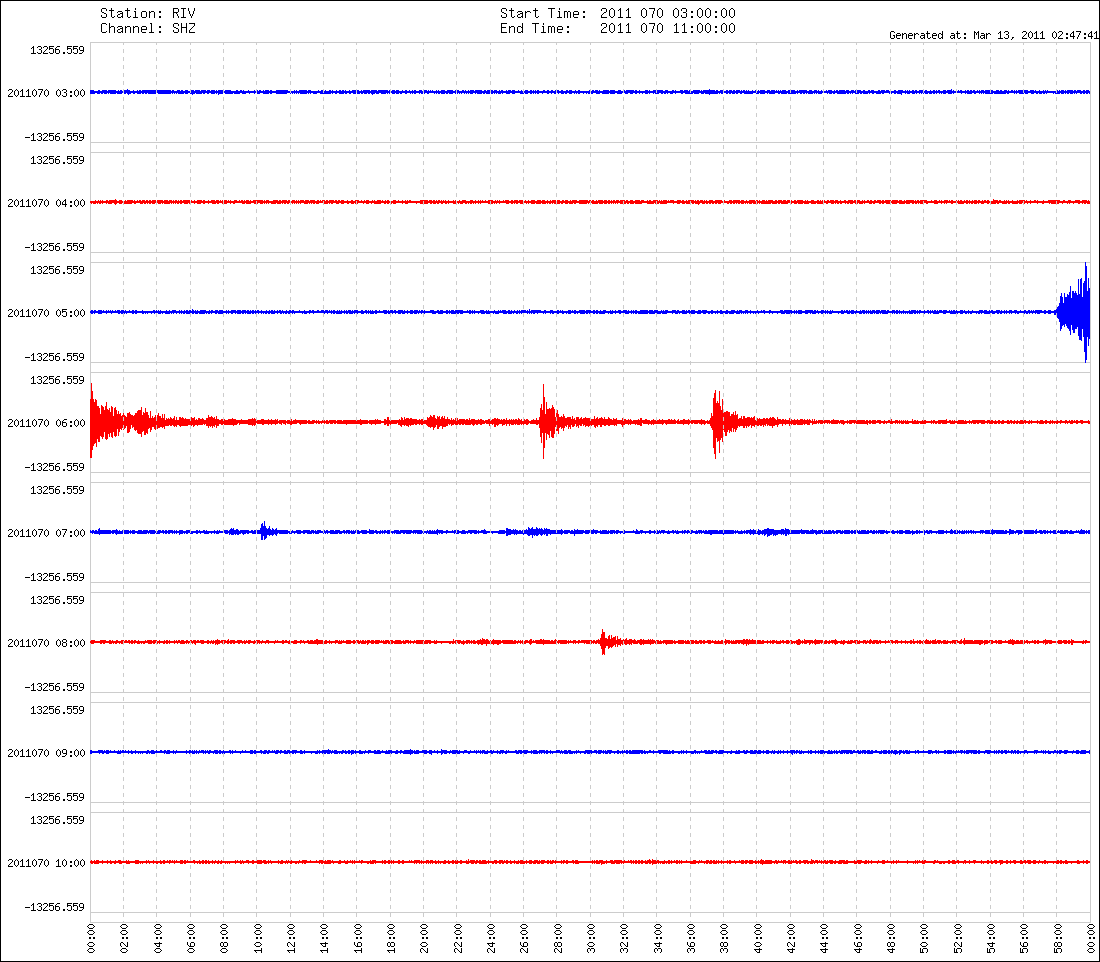Mar 12 2011
The Richter Scale
Seismograph at Riverview Observatory, Sydney.
The Earthquake this weekend in Japan measured 8.9 on the Richter Scale. Christchurch’s earthquake on Feb 21st scored 6.3. Yet they say Japan’s was 1000 times stronger than New Zealand’s. How does that work?
The magnitude of an earthquake is measured using a scale developed by Charles Richter in 1934. It is based on the largest earth movement detected during a quake on a seismograph. The range of possible wave amplitudes is vast – from tiny movements that humans won’t notice to the enormous tremors we have seen in Japan and NZ.
This is the seismograph recording taken from the Riverview Observatory in Syndey on March 11th this week. You can see the Honshu earthquake hitting at 5.46 (UTC)
Because of the large range of possible readings, the Richter Scale is logarithmic. This means that a quake that is one unit bigger than another on the scale actually causes 10 times more movement. A quake measuring 9 causes ten times bigger movement than a quake measuring 8, one hundred times more than a quake measuring 7, and a thousand times more than a quake measuring 6.
This table, reproduced from http://www.geo.mtu.edu/UPSeis/magnitude.html, shows how earthquakes are graded according to this scale.
Earthquake Magnitude Scale
| Magnitude | Earthquake Effects | Estimated Number Each Year |
| 2.5 or less | Usually not felt, but can be recorded by seismograph. | 900,000 |
| 2.5 to 5.4 | Often felt, but only causes minor damage. | 30,000 |
| 5.5 to 6.0 | Slight damage to buildings and other structures. | 500 |
| 6.1 to 6.9 | May cause a lot of damage in very populated areas. | 100 |
| 7.0 to 7.9 | Major earthquake. Serious damage. | 20 |
| 8.0 or greater | Great earthquake. Can totally destroy communities near the epicenter. | One every 5 to 10 years |
So the Richter Scale measures the amount of shaking movement an earthquake causes. However, the actual destructive power of an earthquake (it’s seismic power) scales to a higher factor against the amount of movement. So, a difference of one on the Richter Scale means 10 times the amount of shake but 30 times the destructive power. A difference on the Richter Sale of 2 means 100 times more movement but 1000 times more destructive power. Hence the relationship quoted in the initial text above. The Christchurch earthquake had 42 Kilotons of energy – the Japanese earthquake 336 Megatons!
The amount of damage done by a quake to a city also depends on how close the epicenter of the quake is to the city centre, how deep the quake is, and on the nature of the buildings in the city.
The earthquake in Christchurch was only 6km from the city center, at a depth pf 5km. The Japanese earthquake was 130km from Sendai (in the Pacific Ocean) at a depth of 24km. (most of the destruction has been caused by the ensuing tsunamai).
Earth tremors occur every 5 minutes in Japan, and there are 2000 quakes a year that can be felt by people. Because of the risk, traditional houses use paper architecture, and there are earthquake instruction signs in every building. This all seemed funny when we were there – but very sensible now.
On the US Geological Survery site you can compare detailed measurements of the Japanese earthquake on March 11th and of the Christchurch quake on Feb 21st
The recent Japanese earthquake was one of the largest ever recorded. The Indian Ocean earthquake in 2004 (which caused the devastating Tsunamai_ measured 9.3, and the largest earthquake ever recorded was the Valdivia earthquake in Chile in 1960, measuring 9.5.
It is somewhat sobering to view all the earthquakes happenning around the world each day. There have been 507 earthquakes in the last week, as shown on the map below. You can check the live report here.





 RSS - Posts
RSS - Posts


Leave a Reply